

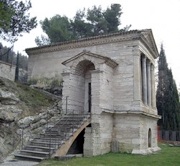
This building, which was known as the church of San Salvatore until its de-consecration in 1810, stands on the River Clitunno, some 600m from its source (see the page on the Fonte del Clitunno). Today, the river is reduced to a canal and on old mill stands between its banks and the church.
San Salvatore was first documented in 1330, but it is certainly much older than that: it might be the oldest surviving church in Umbria. For many centuries, it was believed to have been adapted from a pagan temple (which gives it its usual title of “Tempietto”). For example, Andrea Palladio, who visited it in 1545 and included it in his "I Quattro Libri dell Architettura" (1570), commented that "the ancients took the greatest pains to finish every part minutely ...". Some authorities claimed it as the "ancient and venerable" temple of the river god Clitumnus that Pliny the Younger described in his letter to Romanus (late 1st century AD).
Recent study has demonstrated that the structure was, in fact, always a church, albeit that it may contain re-used architectural fragments from one or more of the temples that stood nearby. It was certainly built after 312 AD (see the description of the aedicule on the east wall below). It might well have been built by a Lombard duke of Spoleto, perhaps in the late 7th century, when the Lombards were finally at peace with the Byzantine emperor. This would account for a Byzantine icon in the conch of the apse (see below).
Architecture
The small, two-storey structure stands on the slope of a steep hill.
The upper storey comprises:
-
✴an open narthex above a pediment, with a facade of four Corinthian columns and two lateral pilasters, which was originally reached by steps to each side; and
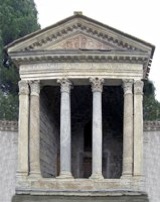
-
✴the main room of the church behind it, which terminates in a half-buried, semi-circular apse.
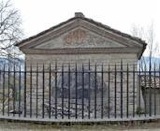
The door at the centre of the pediment leads to the T-shaped crypt.
The most imposing aspect of the structure is its facade. Despite its resemblance to a pagan temple (albeit an unorthodox one), its iconography is clearly Christian:

There is a a relief of a Christian cross in the tympanum (as well as a similar one above the apse, as illustrated above).
The inscription below, which is bracketed by crosses, reads:
"Scs Deus Angelorum qui fecit resurectionem"
God of the Angels, who brought about the resurrection
This inscription was originally matched by two others, one on each side entrance:
"Scs Deus Prophetarum qui fecit redemptionem"
God of the Prophets, who brought about the redemption
"Scs Deus Apostolorum qui fecit remissionem"
God of the Apostles, who brought about the remission of sins
The sides of the structure suffered irreversible re-modeling after an earthquake in 1730. The colonnaded facades in front of the side entrances were dismantled and much of the discarded material was sold. Fragments from the inscriptions above these entrances are now displayed inside: these refer (like the one that survives in situ on the front) to the role of Christ (San Salvatore) in the remission of sins and redemption.
The structure also suffered a series of "restorations" after 1730. The steps that originally led to the narthex, which projected forwards (i.e. at right angles to the facade), were destroyed in an earthquake in the 19th century. The present steps on the left were built parallel to the facade in 1886. The church was restored as far as possible to its original appearance in the 1980s and 1990s.
Interior
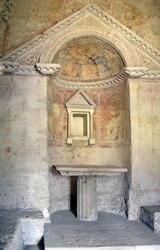

The frescoes in the apse comprise:
-
✴a Byzantine image of Christ in the conch;
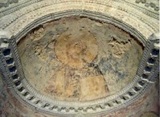
-
✴St Peter (to the left); and
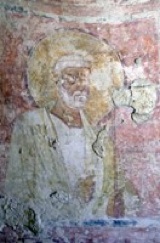
-
✴St Paul (to the right).
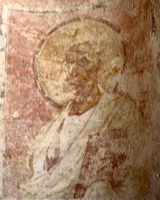
Read more:
J. Emerick, "The Tempietto del Clitunno near Spoleto", Pennsylvania (1998)
Return to Monuments of Spoleto.
Return to the page on drives around Spoleto.

